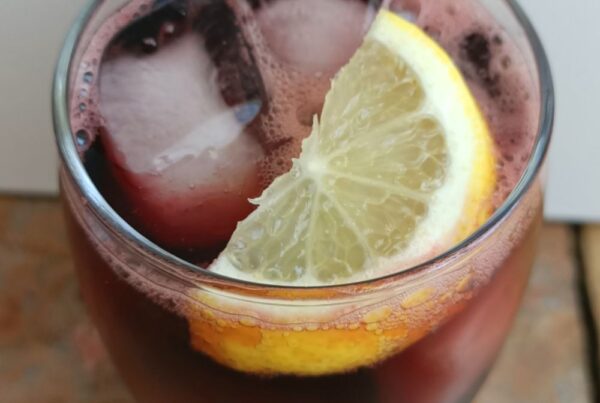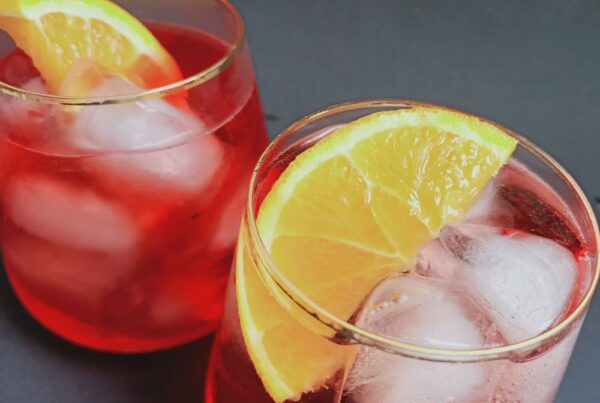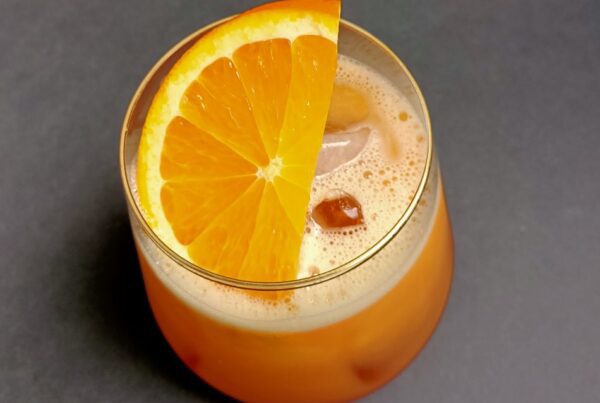Porto Tonico or Port and tonic is a delicious and refreshing drink.
It is a popular summer drink in Porto, Portugal.

Contents
Porto Tonico ingredients
This cocktail requires just two ingredients plus ice and a garnish:
White Port wine
White Port is a fortified wine from Portugal made using white grapes. Fortified wines are wine that have grape spirit added to a base wine.
There are different styles of White Port that have different aging periods and sweetness levels.
The majority of Port wine is red and made with red grapes, but White Port is made with white grapes.
White Port (like its Ruby counterpart) is sweet and full-bodied with intense aromas and flavors.
Young White Port has fresh fruity and floral aromas.
Aged and mature White Ports develop complex tertiary aromas such as nuts, honey and dried fruits (apricots).
To learn more about the different types of White Port and White Port sweetness levels, see this more detailed article on White Port wine.
Tonic water
Tonic water is a non-alcoholic carbonated mixer made with quinine.
The quinine gives it a distinctive citrus, slightly bitter taste.
There are several branded and supermarket versions available these days. You can use any brand you want.
Many brands are now also making tonic water with different flavors.

How to make Porto Tonico
Porto Tonico is incredibly easy to make. No cocktail shakers or fancy equipment necessary here!
You’ll simply fill a wine glass with ice, then add White Port, tonic water and a slice of lemon or lime.
How to adjust your Porto Tonico
Make Porto Tonico sweeter
Most White Port wine is sweet and some are incredibly sweet.
If you prefer sweeter drinks, you can use a sweeter style of White Port wine.
The sweetest styles of White Port are Lágrima/Extra Sweet White Port.
See my article on White Port to find a helpful table with sugar/sweetness levels for White Port wine.
Make Porto Tonico drier
The driest White Port wine that is made is Taylor’s Dry Chip White Port. So, if you prefer dry drinks, this is definitely the White Port to go for.
Make Porto Tonico stronger
I use a 1:3 ratio for this recipe. You can make your Porto Tonico stronger by going for a 1:2 ratio; For example, 2 ounces of port and 4 ounces of tonic water.
When to serve Porto Tonico
White Port is generally considered a pre-dinner drink or apéritif.
It can also work well for parties and gatherings.
Porto Tonico is usually considered a summer drink, but there is no reason that you can’t drink it all year round.
It is the Portuguese version of gin and tonic and we don’t just drink those in summer, right?!
What to serve with Porto Tonico
Porto Tonico is commonly served as an apéritif.
Apéritifs are drinks served before a meal to stimulate the appetite. They’re often light in alcohol and tend to be dry rather than sweet.
Serve your Porto Tonico with tasty apéro (appetizers).
Here are some simple options that pair well:
- An assortment of olives
- Mixed nuts
- A cheese and charcuterie board
- Mini tartlets
- Mini quiches
How to serve White Port
White Port should be served chilled between 6ºC (43ºF) to 10ºC (50ºF).
More Port wine cocktails
Here are a few of my favorite Port wine cocktails:

White Port and tonic / Porto Tonico
Ingredients
- 3 oz White Port 85 ml
- 9 oz Tonic water 250 ml
- Ice cubes
- Slice of lemon
Instructions
- Fill a glass with ice cubes.
- Add the Port and tonic water.
- Garnish with lemon or lime.





